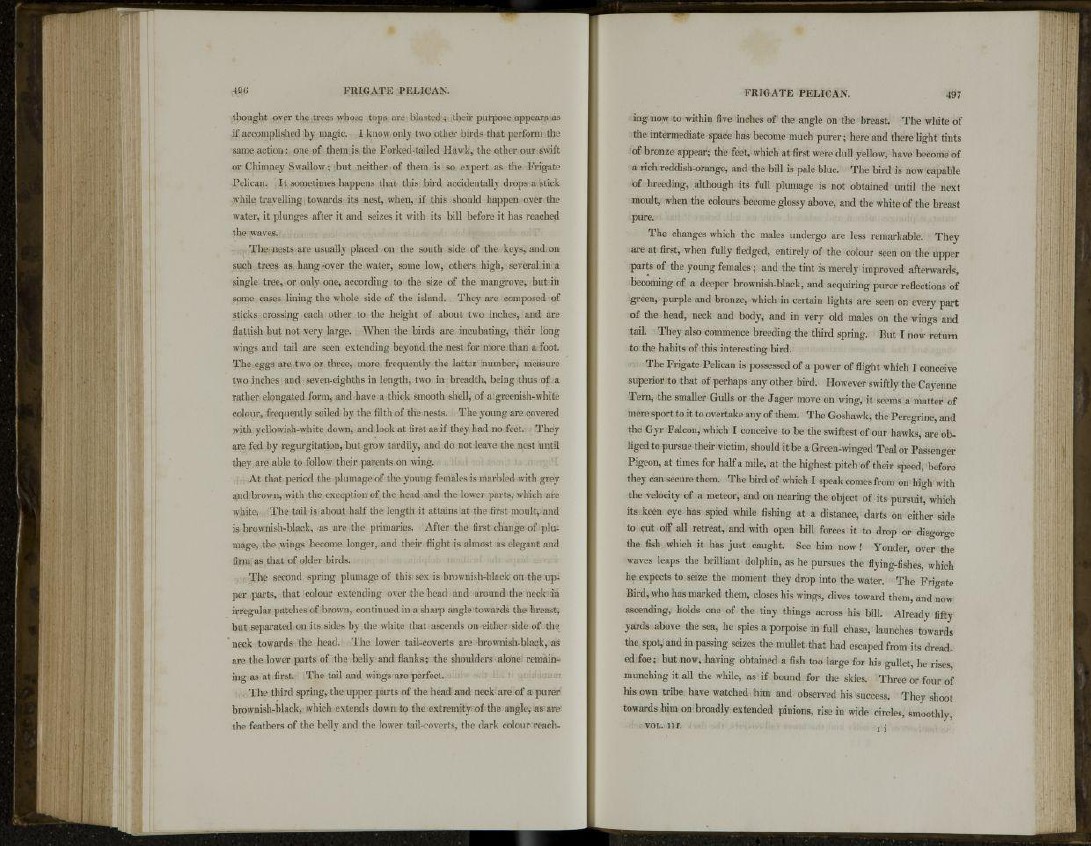
thought over the trees whose tops are blasted ; their purpose appears as
if accomplished by magic. I know only two other birds that perform the
same action: one of them is the Forked-tailed Hawk, the other our swift
or Chimney Swallow; but neither of them is so expert as the Frigate
Pelican. It sometimes happens that this bird accidentally drops a stick
while travelling towards its nest, when, if this should happen over the
water, it plunges after it and seizes it with its bill before it has reached
the waves.
The nests are usually placed on the south side of the keys, and on
such trees as hang -over the water, some low, others high, several in a
single tree, or only one, according to the size of the mangrove, but in
some cases lining the whole side of the island. They are composed of
sticks crossing each other to the height of about two inches, and are
flattisli but not very large. When the birds are incubating, their long
wings and tail are seen extending beyond the nest for more than a foot.
The eggs are two or three, more frequently the latter number, measure
two inches and seven-eighths in length, two in breadth, being thus of a
rather elongated form, and have a thick smooth shell, of a greenish-white
colour, frequently soiled by the filth of the nests. The young are covered
with yellowish-white down, and look at first as if they had no feet. They
are fed by regurgitation, but grow tardily, and do not leave the nest until
they are able to follow their parents on wing.
At that period the plumage of the young females is marbled with grey
and brown, with the exception of the head and the lower parts, which are
white. The tail is about half the length it attains at the first moult, and
is brownish-black, as are the primaries. After the first change of plumage,
the wings become longer, and their flight is almost as elegant and
firm as that of older birds.
The second spring plumage of this sex is brownish-black on the upper
parts, that colour extending over the head and around the neck in
irregular patches of brown, continued in a sharp angle towards the breast,
but separated on its sides by the white that ascends on either side of the
neck towards the head. The lower tail-coverts are brownish-black, as
are the lower parts of the belly and flanks; the shoulders alone remaining
as at first. The tail and wings are perfect.
The third spring, the upper parts of the head and neck are of a purer
brownish-black, which extends down to the extremity of the angle, as are
the feathers of the belly and the lower tail-coverts, the dark colour reaching
now to within five inches of the angle on the breast. The white of
the intermediate space has become much purer; here and there light tints
of bronze appear; the feet, which at first were dull yellow, have become of
a rich reddish-orange, and the bill is pale blue. The bird is now capable
of breeding, although its full plumage is not obtained until the next
moult, when the colours become glossy above, and the white of the breast
pure.
The changes which the males undergo are less remarkable. They
are at first, when fully fledged, entirely of the colour seen on the upper
parts of the young females ; and the tint is merely improved afterwards,
becoming of a deeper brownish-black, and acquiring purer reflections of
green, purple and bronze, which in certain lights are seen on every part
of the head, neck and body, and in very old males on the wings and
tail. They also commence breeding the third spring. But I now return
to the habits of this interesting bird.
The Frigate Pelican is possessed of a power of flight which I conceive
superior to that of perhaps any other bird. However swiftly the Cayenne
Tern, the smaller Gulls or the Jager move on wing, it seems a matter of
mere sport to it to overtake any of them. The Goshawk, the Peregrine, and
the Gyr Falcon, which I conceive to be the swiftest of our hawks, are obliged
to pursue their victim, should it be a Green-winged Teal or Passenger
Pigeon, at times for half a mile, at the highest pitch of their speed, before
they can secure them. The bird of which I speak comes from on high with
the velocity of a meteor, and on nearing the object of its pursuit, which
its keen eye has spied while fishing at a distance, darts on either side
to cut off all retreat, and with open bill forces it to drop or disgorge
the fish which it has just caught. See him now ! Yonder, over the
waves leaps the brilliant dolphin, as he pursues the flying-fishes, which
he expects to seize the moment they drop into the water. The Frigate
Bird, who has marked them, closes his wings, dives toward them, and now
ascending, holds one of the tiny things across his bill. Already fifty
yards above the sea, he spies a porpoise in full chase, launches towards
the spot, and in passing seizes the mullet that had escaped from its dreaded
foe; but now, having obtained a fish too large for his gullet, he rises,
munching it all the while, as if bound for the skies. Three or four of
his own tribe have watched him and observed his success. They shoot
towards him on broadly extended pinions, rise in wide circles, smoothly,
VOL. nr. i i